Abstract
Purpose:
To compare the outcome of Collagen cross-linking (CXL) with that following topography-guided customized ablation treatment (T-CAT) with simultaneous CXL in eyes with progressive keratoconus.
Materials and Methods:
This was a prospective, non-randomized single centre study of 66 eyes with progressive keratoconus. Of these, 40 eyes underwent CXL and 26 eyes underwent T-CAT + CXL. The refractive, topographic, tomographic and aberrometric changes measured at baseline, 1, 3 and 6 months post-operatively were compared between both groups.
Results:
After a mean follow-up of 7.7 ± 1.3 months, the mean retinoscopic cylinder decreased by 1.02 ± 3.16 D in the CXL group (P = 0.1) and 2.87 ± 3.22 D in the T-CAT + CXL group (P = 0.04). The Best corrected visual acuity increased by 2 lines or more in 10% of eyes in the CXL group and in 23.3% of eyes in the T-CAT + CXL group. The mean steepest-K reduced by 0.40 ± 3.71 D (P = 0.77) in the CXL group and by 2.91 ± 2.01D (P = 0.03) in the T-CAT + CXL group. The sag factor and surface asymmetry index showed no significant change in the CXL group but reduced by 3.59 ± 5.94 D (P = 0.01) and 0.72 ± 1.18 (P = 0.02) respectively in the T-CAT + CXL group. There was a significant increase in the highest posterior corneal elevation in both groups (9.57 ± 14.93 μ in the CXL group and 7.85 ± 9.25 μ in the T-CAT + CXL group, P ≤ 0.001 for both). There was significantly greater reduction of mean coma (P < 0.001) and mean higher-order aberrations (P = 0.01) following T-CAT + CXL compared to CXL.
Conclusions:
CAT + CXL is an effective approach to confer biomechanical stability and to improve the corneal contour in eyes with keratoconus and results in better refractive, topographic and aberrometric outcomes than CXL alone.
Keywords: Collagen cross linking, keratoconus, topography guided custom ablation treatment, topography guided photoablation
Corneal Collagen cross-linking (CXL) was introduced by Wollensak et al.[1] as a promising treatment strategy to stabilize progressive keratoconus. Since 2003, when the results of the first clinical trials were published, and more so in the last 2 years, numerous publications confirm the clinical efficacy and safety of the procedure.[2,3,4,5,6,7,8,9] These reports suggest not only a consistent stabilizing effect but also variable degree of corneal flattening in most patients. The two main problems with keratoconus are the biomechanical instability, which makes it a progressive disease and irregular astigmatism, which causes it to be a visually incapacitating disease. While corneal CXL is believed to strengthen the biomechanics of the cornea, it does not adequately address the problem of irregular astigmatism. Attempts have therefore been made to combine CXL with other techniques that are aimed at reducing the irregular astigmatism. One such attempt was popularized by Kanellopoulos[10] who combined the CXL with a topography-guided customized ablation treatment (T-CAT). First attempted sequentially, but later adopted as a simultaneous combined technique of T-CAT with CXL, the results were reported to be even better.[11,12]
The physicochemical changes in the corneal stroma induced by CXL have been well documented.[13,14,15,16,17,18] Most clinical studies use corneal curvature as the main outcome measure of the therapeutic effect of CXL, although changes in visual acuity and refraction have also been documented.[1,2,3,4,5,6,7] In addition to these, Vinciguerra et al.[8] studied the topographic indices, tomographic changes and analyzed the corneal and total wavefront aberrations of keratoconic eyes that underwent CXL. Tu et al.[19] used the Orbscan II to identify two different patterns of anterior elevation change, probably influenced by the known anisotropy of Collagen in the cornea. To the best of our knowledge, there has been no published study that analyses regional differences in the response of a keratoconic cornea to CXL or to T-CAT with CXL, or any that compares the clinical results of CXL with those of combined simultaneous T-CAT + CXL.
The aims of our study were to analyze the refractive, topographic, tomographic and corneal aberration changes in keratoconic eyes, which underwent CXL and compare them with eyes that underwent a simultaneous combined T-CAT + CXL. This study also examined regional changes within the cornea in terms of their response to both forms of the procedure, and analyses possible factors that could influence those changes.
Materials and Methods
This was a prospective non-randomized single-centre study of 66 eyes of 50 patients with progressive keratoconus seen at the Cornea Services of a Tertiary eye care centre between January and December 2010.
“Progression” in keratoconus was defined as an increase of >1.0 D of refractive astigmatism or an increase of >1.5 D in average K by keratometry/topography or a decrease of >5% in central corneal thickness within the previous 1 year.
Inclusion criteria
Patients with documented progression in keratoconus and with a minimum corneal thickness of 400 μ at the thinnest point were included in the study. All patients had a minimum of 3 months follow-up after the procedure. Data collected during the 3 months to 6 months post-op follow-up visits were used for statistical analysis.
Exclusion criteria
Eyes with corneal thickness less than 400 μ at the thinnest point on the cornea, eyes with corneal scars or evidence of previous hydrops, pregnant women and lactating mothers were excluded from the study.
Criteria for choice of treatment
Eyes with a minimum corneal thickness of more than 450 μ, with clear mires on the Topolyzer, which covered more than 50% of the corneal area were selected for the combined simultaneous T-CAT + CXL procedure. The rest underwent CXL alone.
This study received approval by the Institutional Review Board and Ethics Committee and adhered to the tenets of the Declaration of Helsinki. All patients recruited for the study signed an informed consent.
All patients underwent retinoscopy, measurement of their best spectacle corrected visual acuity (BSCVA) on the early treatment diabetic retinopathy study (ETDRS) chart, slit lamp biomicroscopy, Goldmann applanation tonometry, dilated fundus examination, corneal topography with TMS IV (Tomey Inc) and Topolyzer (Oculus Inc), corneal tomography (Pentacam HR, Oculus Inc) pre-operatively and again post-operatively at all follow-up visits. Corneal aberrations were calculated using the Vol CT software (Version 6.56).
The keratoconus was classified as mild, moderate or severe, using the criteria adopted in the Collaborative longitudinal evaluation of keratoconus study.[20] The pattern of keratconus was classified as central/global, localized steepening and symmetric or asymmetric bowtie.
Cross-linking procedure
The technique of CXL in all patients followed the Dresden protocol.[2] It was conducted in sterile conditions under topical anaesthesia of 0.5% Proparacaine (Sunways [India] Pvt. Ltd.). A wire speculum was used to separate the lids and the central 9 mm of the cornea was debrided of its epithelium. Riboflavin 0.1% solution (10 mg riboflavin–5-phosphate in 10 ml of 20% dextran-T 500) was instilled every 3 min for 30 min to photosensitize the cornea. After confirming the presence of riboflavin in the anterior chamber using the slit lamp with a blue filter, the cornea was exposed to ultraviolet-A (UVA) irradiation (UV-X system, Peschke Meditrade GmbM, Switzerland) of 370 nm wavelength and an irradiance of 3 mW/cm2 for 30 min.
Topography-guided customized ablation treatment with Collagen cross-linking
A trans-epithelial T-CAT was performed in a manner similar to the Athens protocol.[10] In brief, it consists of importing the raw topographic data captured by the Topolyzer. Only maps with clear mires, where >50% of the corneal surface was analysed without extrapolated data and those which imaged the pupil fully were accepted. The Allegretto Excimer Laser (400 Hz EyeQ, Wavelight, Erlangen) which has a customized platform for T-CAT, has proprietary software that averages the imported topographic data and allows the surgeon to adjust the optical zone of treatment, the asphericity, tilt correction and refractive error. An optical zone of 5.5 mm with asphericity and refractive error kept at zero with no tilt correction was chosen in all cases in the study.
Immediately following the T-CAT, the cornea was photosensitized with Riboflavin in preparation for the CXL as detailed above.
Following CXL or T-CAT with CXL, a bandage contact lens was placed on the cornea and the patient was put on topical Ciprofloxacin eye drops 4 times a day for 1 week and Prednisolone acetate 1% (Pred Forte, Allergan) 4 times a day for 1 week and tapered over 1 month.
Outcome measures
The outcome measures in this study included retinoscopic and subjective refraction, BSCVA, the simulated K and Steepest K from the corneal topography, the “sag factor” [the maximum dioptre difference between the peak of the cone and a point that was as equidistant and equiangular as the peak was from the centre of the cornea, depicted diagrammatically in Fig 1], the area of the cone (using the Mat Lab version 7.03 a) the base of the cone (the dioptre power of the mean curvature of the cornea, determined by the mid-value in the normalized scale), the Smolek-Klyce and Klyce-Maeda indices of clinical similarity and pattern severity, the topographic indices of surface regularity and asymmetry (SRI and SAI) and Keratoconus prediction index (KPI) and corneal aberrations at 6 mm.
Figure 1.
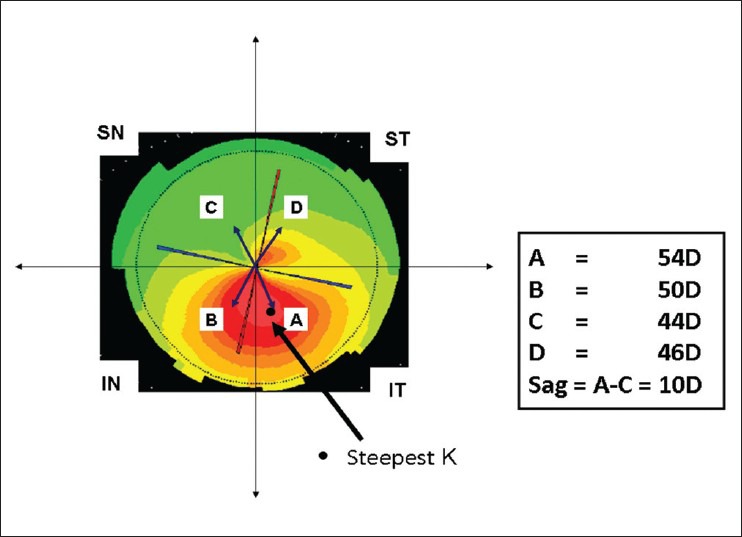
Diagrammatic representation of “Sag” factor
Data analysis
Statistical analyses were performed with MS Excel and SPSS14. Non-parametric mean comparisons were done using Mann-Whitney U test.
All data are reported as mean values ± standard deviation. The level of statistical significance was set at P < 0.05.
Results
A total of 66 eyes of 50 patients were included in this study. Of these, 40 eyes of 27 patients underwent CXL alone, while 26 eyes of 23 patients underwent simultaneous T-CAT + CXL. The mean follow-up was 7.7 ± 1.3 months (3-16.5 months). The pre-operative parameters in each group and the statistical analysis of their differences are given in Tables 1 and 2. The CXL group consisted of eyes with more severe grade of keratoconus, steeper mean K, higher mean posterior corneal elevation and thinner mean corneal pachymetry than the eyes in the T-CAT + CXL group. The mean values of other parameters like retinoscopic cylinder, Spherical equivalent, sag factor, area of cone, SAI were comparable in both groups. Table 3 summarizes the changes in refractive, visual and topographic parameters in each group and the statistical difference between the two groups.
Table 1.
Preoperative demographic and refractive parameters in each group and the statistical differences between them
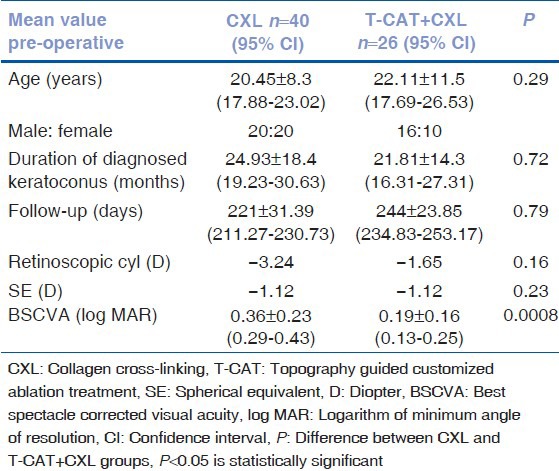
Table 2.
Pre-operative topographic and tomographic parameters in each group and the statistical differences between them
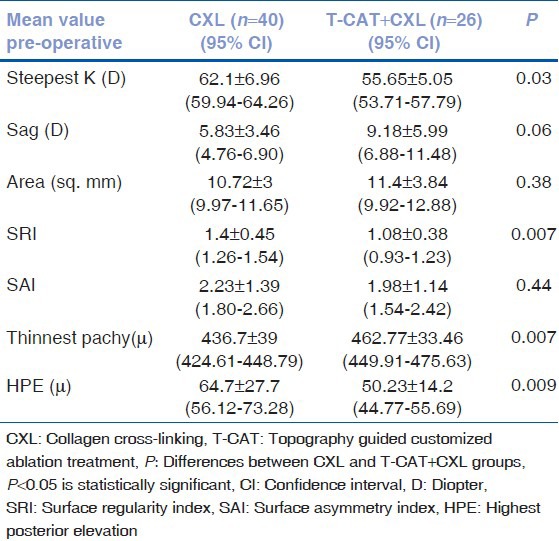
Table 3.
Changes in refractive, visual and topographic parameters following treatment in each group and statistical differences within and between each group
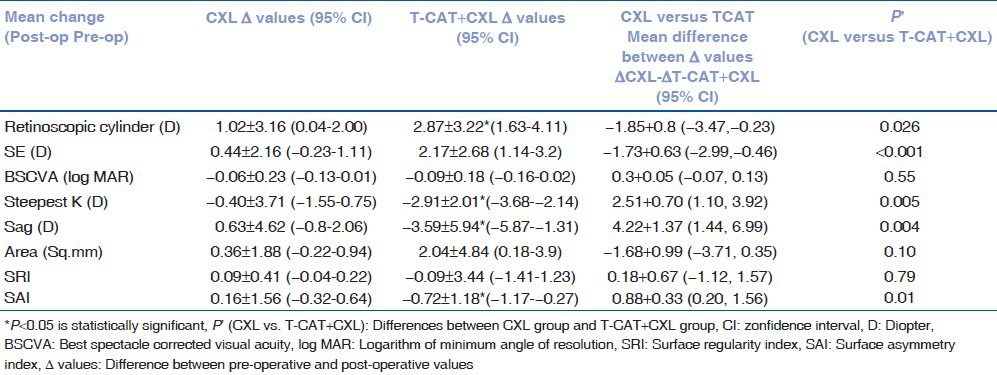
Refractive and visual results
The retinoscopic cylinder decreased by 1.02 D ± 3.16 D in the CXL group (P = 0.11) and by 2.87 ± 3.22 D in the T-CAT + CXL group (P = 0.039). The difference between the 2 groups was also statistically significant (P = 0.026).
The mean spherical equivalent (SE) decreased by 0.44 + 2.16 D in the CXL group (P = 0.65) and by 2.17 ± 2.68 D in the T-CAT + CXL group (P = 0.21). The difference between the 2 groups was statistically significant (P ≤ 0.001)
The BSCVA expressed in logarithm of minimum angle of resolution (log MAR) improved by a mean of 0.06 ± 0.23 in the CXL group and by a mean of 0.09 ± 0.18 in the T-CAT + CXL group. The change in BSCVA after treatment in each group and between the 2 groups were not statistically significant. However, 4 of 40 eyes (10%) in the CXL group and 6 of 26 eyes (23.3%) in the T-CAT + CXL group showed an increase of 2 lines or more in BSCVA following treatment.
Topographic results
The steepest K reduced by mean of 0.40 ± 3.71 D (P = 0.77) in the CXL group and by a mean of 2.9 ± 2.0 D (P 0.03) in the T-CAT ± CXL group. The change in K between the 2 groups was also statistically significant (P = 0.005). The steepest K reduced by >2 D in 17.5% of eyes in the CXL group and in 33.3% of eyes in the T-CAT + CXL group.
The base of the cone flattened by a mean of 1.39 ± 13.41 D in the CXL group (P = 0.86) and by a mean of 4.94 ± 11.46 D in the T-CAT + CXL group (P = 0.05).
The sag factor and surface asymmetry index showed no significant change in the CXL group but reduced significantly by 3.59 ± 5.94 D (P = 0.01) and 0.72 ± 1.18 (P = 0.02) respectively in the T-CAT + CXL group.
There was an increase in the area of the cone in both groups, more so in the T-CAT + CXL group, although these changes were not statistically significant.
Table 4 summarizes the changes in the keratoconus indices: The Klyce Maeda index for pattern similarly, the keratoconus index (KCI), the Keratoconus severity index and the KPI showed no significant changes in the CXL group but reduced significantly in the T-CAT + CXL group (P < 0.005 in all).
Table 4.
Changes in topographic keratoconus indices before and after treatment and their statistical differences in each group

Tomographic results
The corneal pachymetry at the thinnest point, as measured by the Pentacam, showed a reduction following treatment in both groups. Although the reduction from the pre-operative values was not statistically significant in either group, the change in thickness was significantly more in the T-CAT + CXL group than in the CXL group (P = 0.007). There was a significant decrease in the highest anterior evaluation and a significant increase in highest posterior elevation following CXL (P < 0.001 in both). There was a significant increase in highest anterior and posterior corneal elevation following T-CAT + CXL (P < 0.001 in both).
Corneal aberrations
Table 5 shows the pre-operative and post-operative mean corneal aberrations for coma, spherical aberration and the root mean square of total higher order aberrations (RMSh) in both groups. There was a significant reduction in the mean coma and RMSh and a significant increase in the mean spherical aberration in the T-CAT + CXL group. There were no significant changes in the mean coma, spherical aberration or RMSh in the CXL group.
Table 5.
Corneal aberrations (6 mm dia) in each group and the statistical differences between them

Changes in pattern
Fig. 2a and b show the change in the distribution of patterns of cones in each group. There was a marked tendency for greater symmetrization in the T-CAT + CXL group. There was a perceptible trend for many of the eyes with an asymmetric bowtie prior to treatment to appear more symmetric following T-CAT + CXL. In the CXL group, on the other hand, the pattern of cone did not appear to change appreciably. Fig 3 shows an example of two eyes with similar pre-operative pattern and severity of keratoconus. One eye underwent CXL alone whereas the other underwent T-CAT + CXL. The 6-month post-operative topography demonstrates the observation mentioned above.
Figure 2.
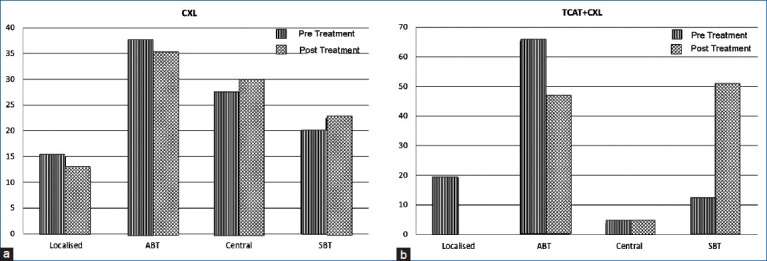
(a) Bar diagram showing change in pattern of cone in collagen cross linking, (b) Bar diagram showing change in pattern of cone in T-customized ablation treatment + collagen cross linking
Figure 3.
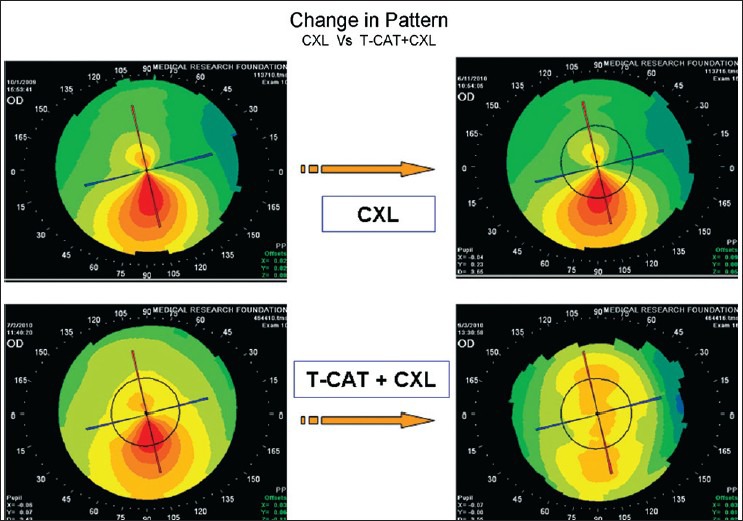
Pre-operative and 6 months post-operative corneal topography of two topographically similar eyes, one of which underwent collagen cross linking (CXL) alone and the other T-customized ablation treatment + CXL
Odds ratio for symmetrization of cone and flattening of Cornea
Parameters like age of the patient, duration of disease, severity and pattern of keratoconus were considered to calculate the odds ratio for symmetrization of the cone and flattening of the cornea. An asymmetric pattern had an odds ratio of 2.62 for symmetrization of the cone in the T-CAT + CXL group. A mean K of <52 D (mild severity) had an odds ratio of 3.54 for flattening in the T-CAT + CXL group, and an odds ratio of 1.25 for flattening in the CXL group.
Discussion
Over the last decade, several clinical studies have confirmed the efficacy of the CXL procedure in arresting the progression of keratoconus.[2,3,4,5,6,7,8,9] However, CXL alone does not reduce the irregularity in corneal shape. The visually incapacitating symptoms due to irregular astigmatism and high corneal aberrations, are therefore likely to persist. A few attempts have been made to combine CXL with other procedures that could reduce irregular astigmatism. Intrastromal corneal ring segments have been proposed as one such technique, combined with CXL.[21,22] Topography guided photorefractive keratectomy along with CXL is another.[23,24,25] This approach has been popularized by Kanellopoulos et al., who after initial attempts with a sequential technique,[10] showed that a simultaneous T-CAT + CXL was the preferred approach to regularize and stabilize the cornea in Keratoconus.[11] This simultaneous, combined procedure has been used in progressive keratoconus, Pellucid marginal degeneration and post-Lasik keratectasia with encouraging results.[12,26,27] There has, however, been no published study that compares the results of CXL alone with those of simultaneous, combined T-CAT + CXL. Our results clearly indicate that a combined T-CAT + CXL resulted in better refractive, topographic and aberrometric outcomes than CXL alone. The reduction in refractive cylinder and in the steepest topographic K was significantly more in the T-CAT + CXL group than in the CXL group. The change in topographic patterns in the 2 groups reflected the same results; the trend towards symmetrization of the asymmetric bowtie patterns in the T-CAT + CXL group was significant in contrast to the relatively changeless topographic pattern in the CXL group. The significantly greater decrease in the “sag factor” is a quantitative indicator of the symmetrization being more effective in the T-CAT + CXL group. The topographic indices of regularity and asymmetry (SRI and SAI), particularly the latter, were also significantly better after the combined procedure.
The mechanism of topography-guided ablation is the fitting of a best-fit-sphere under the patients topography map with ablation of tissues in between.[11] This would flatten some of the cone apex and explains why these eyes showed more flattening than eyes treated with CXL alone. In addition, the proprietary T-CAT software of the Wavelight Allegretto excimer laser also incorporates a partial hyperopia-like ablation pattern that results in steepening of the cornea adjacent to the base of the cone. It is this combination of flattening of the steep portion and steepening of the flat portion of the cornea that results in the symmetrization seen in topography and a reduction of the refractive cylinder as well as a reduction in the HOA. The reduction in total corneal HOA, particularly in the coma (Z-13) was statistically significantly more in the T-CAT + CXL group than in the CXL group. This would be expected to improve the quality of vision and reduce the annoying optical phenomena like haloes and shadowing of images often associated with irregular astigmatism and coma. CXL alone showed a negligible reduction in RMSh and coma, which were not statistically significant, in agreement with the findings of Vinciguerra et al.[8] T-CAT + CXL did, however, cause a significant increase in the mean spherical aberration. It is interesting to note that the Zernike coefficient of spherical aberration is usually negative in keratoconic eyes, for it is the result of an increased prolateness shape factor in these eyes, especially in eyes with central cones. With localized paracentral cones, as also in eyes with asymmetric bowtie pattern of cones, there is an area of relative flattening in the sector opposite the cone that partially compensates for the increased prolateness due to the cone. In T-CAT, there is a relative steepening of that flat portion, resulting in an overall increase in prolateness, and therefore in the negative Zernike coefficient of spherical aberration.
Our study also demonstrated a slight increase in the area occupied by the cone-more so in the T-CAT + CXL group, where the increase approached statistical significance (P = 0.06). This broadening of the base of the cone may perhaps be the biomechanical response to the flattening, which was more in the T-CAT + CXL group. A flatter and broader cone, as suggested by Kanellopoulos[11] may redistribute the biomechanical strain from forces like the intraocular pressure, or eye rubbing, etc., and may thus represent an additional benefit to the patient.
Although the change in corneal pachymetry was not statistically significant with either procedure, T-CAT + CXL resulted in significantly more thinning than CXL alone. The combined T-CAT + CXL procedure does involve some ablation over the already thin cone and could be a cause for concern. By choosing eyes with a minimum corneal thickness of 450 μ rather than 400 μ (which is recommended for CXL), by limiting the ablation to no more than 50 μ (arbitrarily chosen by Kanellopoulos[11]) and by performing a simultaneous CXL procedure, it is hoped that the combined procedure will not destabilize the biomechanical integrity of the cornea. This emphasizes the need for these eyes to be monitored closely in the post-operative period.
This study does suffer from a few limitations. Although all the eyes in both groups had a minimum corneal thickness of 400 μ, the CXL group consisted of eyes with more severe forms of the disease, and had a significantly worse pre-operative BSCVA than the T-CAT + CXL group. Had the two groups been more similar with respect to the severity of disease and had the treatment been randomized, the scientific credibility of the results would have been more convincing. A longer follow-up of both groups would also be necessary to confirm biomechanical stability. When programming the T-CAT, the choice of keeping the target asphericity and refractive correction at zero and the maximum ablation to less than 50 μ was arbitrary. More data with variations in these parameters are required to understand the effect of those variations and to be able to make recommendations, if any, for suitable changes in the existing protocol. Although our study did suggest that the T-CAT + CXL resulted in flatter, smoother and more symmetric corneal contour than CXL alone, with more number of eyes showing an increase of 2 lines or more in BSCVA we could not demonstrate any overall improvement in BSCVA. A “Quality of life” questionnaire, a measurement of contrast sensitivity and the inclusion of psychophysical tests of quality of vision may have borne out any differences between the two groups that the high contrast Snellen visual acuity may not have measured. This study also did not include any measurements of corneal endothelial changes. When the tenets of the Dresden protocol are not violated, the CXL procedure is believed to pose no threat to the corneal endothelium.[28] Studies have also confirmed that the corneal endothelium cell loss is not significant at 12 months after CXL.[8,4,29] Such data is lacking with the combined T-CAT + CXL procedure. Long-term studies on endothelial cell counts with both techniques are warranted, even though there are no published reports of irreversible endothelial failure complicating CXL so far.
Our study suggests that a combined T-CAT + CXL is an effective approach to not only biomechanically stabilize the cornea in keratoconus, but also to improve the corneal contour, reduce irregular astigmatism and offer a better quality of vision than CXL alone could do. However, long-term followup is needed to establish the safety of this combined procedure and to justify its rationale.
Footnotes
Source of Support: Nil
Conflict of Interest: None declared.
References
- 1.Wollensak G, Spoerl E, Seiler T. Riboflavin/ultraviolet-a-induced collagen crosslinking for the treatment of keratoconus. Am J Ophthalmol. 2003;135:620–7. doi: 10.1016/s0002-9394(02)02220-1. [DOI] [PubMed] [Google Scholar]
- 2.Caporossi A, Baiocchi S, Mazzotta C, Traversi C, Caporossi T. Parasurgical therapy for keratoconus by riboflavin-ultraviolet type A rays induced cross-linking of corneal collagen: Preliminary refractive results in an Italian study. J Cataract Refract Surg. 2006;32:837–45. doi: 10.1016/j.jcrs.2006.01.091. [DOI] [PubMed] [Google Scholar]
- 3.Raiskup-Wolf F, Hoyer A, Spoerl E, Pillunat LE. Collagen crosslinking with riboflavin and ultraviolet-A light in keratoconus: Long-term results. J Cataract Refract Surg. 2008;34:796–801. doi: 10.1016/j.jcrs.2007.12.039. [DOI] [PubMed] [Google Scholar]
- 4.Wittig-Silva C, Whiting M, Lamoureux E, Lindsay RG, Sullivan LJ, Snibson GR. A randomized controlled trial of corneal collagen cross-linking in progressive keratoconus: Preliminary results. J Refract Surg. 2008;24:S720–5. doi: 10.3928/1081597X-20080901-15. [DOI] [PubMed] [Google Scholar]
- 5.Jankov MR, 2nd, Hafezi F, Beko M, Ignjatovic Z, Djurovic B, Markovic V, et al. Corneal Cross-linking for the treatment of keratoconus: Preliminary results. Arq Bras Oftalmol. 2008;71:813–8. doi: 10.1590/s0004-27492008000600009. [DOI] [PubMed] [Google Scholar]
- 6.Hoyer A, Raiskup-Wolf F, Spörl E, Pillunat LE. Collagen cross-linking with riboflavin and UVA light in keratoconus. Results from Dresden. Ophthalmologe. 2009;106:133–40. doi: 10.1007/s00347-008-1783-2. [DOI] [PubMed] [Google Scholar]
- 7.Agrawal VB. Corneal collagen cross-linking with riboflavin and ultraviolet-a light for keratoconus: Results in Indian eyes. Indian J Ophthalmol. 2009;57:111–4. doi: 10.4103/0301-4738.44515. [DOI] [PMC free article] [PubMed] [Google Scholar]
- 8.Vinciguerra P, Albè E, Trazza S, Rosetta P, Vinciguerra R, Seiler T, et al. Refractive, topographic, tomographic, and aberrometric analysis of keratoconic eyes undergoing corneal cross-linking. Ophthalmology. 2009;116:369–78. doi: 10.1016/j.ophtha.2008.09.048. [DOI] [PubMed] [Google Scholar]
- 9.Koller T, Iseli HP, Hafezi F, Vinciguerra P, Seiler T. Scheimpflug imaging of corneas after collagen cross-linking. Cornea. 2009;28:510–5. doi: 10.1097/ICO.0b013e3181915943. [DOI] [PubMed] [Google Scholar]
- 10.Kanellopoulos AJ, Binder PS. Collagen cross-linking (CCL) with sequential topography-guided PRK: A temporizing alternative for keratoconus to penetrating keratoplasty. Cornea. 2007;26:891–5. doi: 10.1097/ICO.0b013e318074e424. [DOI] [PubMed] [Google Scholar]
- 11.Kanellopoulos AJ. Comparison of sequential vs same-day simultaneous collagen cross-linking and topography-guided PRK for treatment of keratoconus. J Refract Surg. 2009;25:S812–8. doi: 10.3928/1081597X-20090813-10. [DOI] [PubMed] [Google Scholar]
- 12.Stojanovic A, Zhang J, Chen X, Nitter TA, Chen S, Wang Q. Topography-guided transepithelial surface ablation followed by corneal collagen cross-linking performed in a single combined procedure for the treatment of keratoconus and pellucid marginal degeneration. J Refract Surg. 2010;26:145–52. doi: 10.3928/1081597X-20100121-10. [DOI] [PubMed] [Google Scholar]
- 13.Wollensak G, Spoerl E, Seiler T. Stress-strain measurements of human and porcine corneas after riboflavin-ultraviolet-A-induced cross-linking. J Cataract Refract Surg. 2003;29:1780–5. doi: 10.1016/s0886-3350(03)00407-3. [DOI] [PubMed] [Google Scholar]
- 14.Spoerl E, Wollensak G, Dittert DD, Seiler T. Thermomechanical behavior of collagen-cross-linked porcine cornea. Ophthalmologica. 2004;218:136–40. doi: 10.1159/000076150. [DOI] [PubMed] [Google Scholar]
- 15.Spoerl E, Wollensak G, Seiler T. Increased resistance of crosslinked cornea against enzymatic digestion. Curr Eye Res. 2004;29:35–40. doi: 10.1080/02713680490513182. [DOI] [PubMed] [Google Scholar]
- 16.Mencucci R, Mazzotta C, Rossi F, Ponchietti C, Pini R, Baiocchi S, et al. Riboflavin and ultraviolet A collagen crosslinking: In vivo thermographic analysis of the corneal surface. J Cataract Refract Surg. 2007;33:1005–8. doi: 10.1016/j.jcrs.2007.03.021. [DOI] [PubMed] [Google Scholar]
- 17.Wollensak G, Wilsch M, Spoerl E, Seiler T. Collagen fiber diameter in the rabbit cornea after collagen crosslinking by riboflavin/UVA. Cornea. 2004;23:503–7. doi: 10.1097/01.ico.0000105827.85025.7f. [DOI] [PubMed] [Google Scholar]
- 18.Wollensak G, Redl B. Gel electrophoretic analysis of corneal collagen after photodynamic cross-linking treatment. Cornea. 2008;27:353–6. doi: 10.1097/ICO.0b013e31815cf66a. [DOI] [PubMed] [Google Scholar]
- 19.Tu KL, Aslanides IM. Orbscan II anterior elevation changes following corneal collagen cross-linking treatment for keratoconus. J Refract Surg. 2009;25:715–22. doi: 10.3928/1081597X-20090707-06. [DOI] [PubMed] [Google Scholar]
- 20.McMahon TT, Szczotka-Flynn L, Barr JT, Anderson RJ, Slaughter ME, Lass JH, et al. A new method for grading the severity of keratoconus: The Keratoconus Severity Score (KSS) Cornea. 2006;25:794–800. doi: 10.1097/01.ico.0000226359.26678.d1. [DOI] [PubMed] [Google Scholar]
- 21.Chan CC, Sharma M, Wachler BS. Effect of inferior-segment Intacs with and without C3-R on keratoconus. J Cataract Refract Surg. 2007;33:75–80. doi: 10.1016/j.jcrs.2006.09.012. [DOI] [PubMed] [Google Scholar]
- 22.Kamburoglu G, Ertan A. Intacs implantation with sequential collagen cross-linking treatment in postoperative LASIK ectasia. J Refract Surg. 2008;24:S726–9. doi: 10.3928/1081597X-20080901-16. [DOI] [PubMed] [Google Scholar]
- 23.Tamayo GE, Serrano MG. Treatment of irregular astigmatism and keratoconus with the VISX C-CAP method. Int Ophthalmol Clin. 2003;43:103–10. doi: 10.1097/00004397-200343030-00010. [DOI] [PubMed] [Google Scholar]
- 24.Cennamo G, Intravaja A, Boccuzzi D, Marotta G, Cennamo G. Treatment of keratoconus by topography-guided customized photorefractive keratectomy: Two-year follow-up study. J Refract Surg. 2008;24:145–9. doi: 10.3928/1081597X-20080201-04. [DOI] [PubMed] [Google Scholar]
- 25.Lin DT, Holland SR, Rocha KM, Krueger RR. Method for optimizing topography-guided ablation of highly aberrated eyes with the ALLEGRETTO WAVE excimer laser. J Refract Surg. 2008;24:S439–45. doi: 10.3928/1081597X-20080401-22. [DOI] [PubMed] [Google Scholar]
- 26.Krueger RR, Kanellopoulos AJ. Stability of simultaneous topography-guided photorefractive keratectomy and riboflavin/UVA cross-linking for progressive keratoconus: Case reports. J Refract Surg. 2010;26:S827–32. doi: 10.3928/1081597X-20100921-11. [DOI] [PubMed] [Google Scholar]
- 27.Kanellopoulos AJ, Binder PS. Management of corneal ectasia after LASIK with combined, same-day, topography-guided partial transepithelial PRK and collagen cross-linking: The athens protocol. J Refract Surg. 2011;27:323–31. doi: 10.3928/1081597X-20101105-01. [DOI] [PubMed] [Google Scholar]
- 28.Spoerl E, Mrochen M, Sliney D, Trokel S, Seiler T. Safety of UVA-riboflavin cross-linking of the cornea. Cornea. 2007;26:385–9. doi: 10.1097/ICO.0b013e3180334f78. [DOI] [PubMed] [Google Scholar]
- 29.Vinciguerra P, Albè E, Trazza S, Seiler T, Epstein D. Intraoperative and postoperative effects of corneal collagen cross-linking on progressive keratoconus. Arch Ophthalmol. 2009;127:1258–65. doi: 10.1001/archophthalmol.2009.205. [DOI] [PubMed] [Google Scholar]


